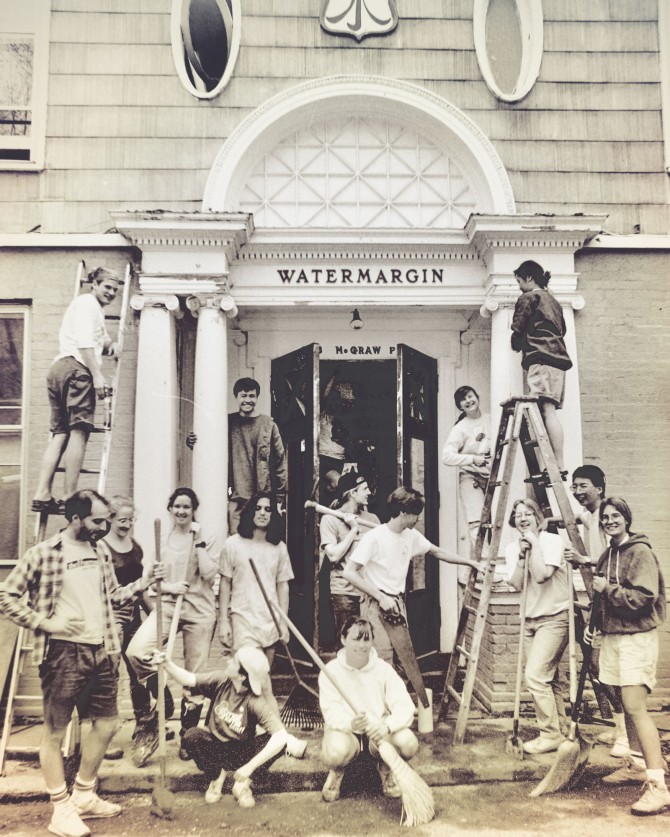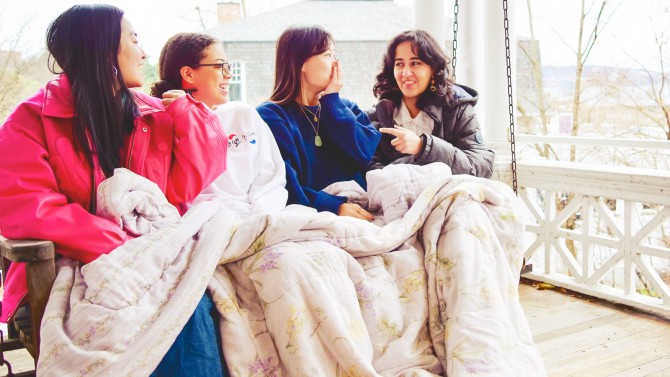
Residents of Watermargin in 1950.
For more than 75 years, students have made Watermargin a home
By Joe Wilensky
“All men are brothers / All people are family,” reads a plaque in the entryway of Watermargin Co-op, at 103 McGraw Place. It’s accompanied by the Chinese character for water, which also appears above the front entrance of the five-story house, founded in fall 1948 and currently home to 23 residents.
“The house’s focus on intergroup living keeps it unique and continues to draw interest from students,” said Lou Hom ’93, a former resident who has remained involved with the co-op and serves on its board of directors. “There are various program houses that tend to focus on individual cultures, but Watermargin was always meant to be an intersectional space.”
The co-op is preparing to mark its 75th anniversary later this spring, with a reunion planned for May 4; details are pending.
Given that milestone, alumni and current members are looking back at its history and how the house continues to promote its ideals. Initially dubbed the United World Foundation, Watermargin was conceived by a group of World War II veterans who were attending Cornell under the G.I. Bill.
Having fought for democracy, they found they could not reconcile the principles for which they’d risked their lives with the widespread discrimination and segregation they saw when they returned to the U.S.
As mature undergraduates with notable life experience, they were inspired to create a community that would promote understanding across races, national origins, and religions.
The group took its name from the English title of a centuries-old Chinese novel, “Shui Hu Zhuan,” which also had long been interpreted as “all men are brothers.” (It had been translated into English in 1933 by a fellow Cornellian: Nobel laureate Pearl Buck, MA 1925.)
Formed and first incorporated in 1947, Watermargin secured its house the following year, leasing it from Cornell beginning in fall 1948.
Watermargin was unique not only at Cornell but nationwide as the first racially integrated, interfaith living unit on a college campus. While women could be members by the 1960s, the rules of the time kept the house itself all male until about 1970.
The house’s ambitious educational outreach program brought high-profile speakers – including Eleanor Roosevelt, Langston Hughes, Margaret Mead, Malcolm X and Marian Anderson – to campus in its early years.
“It seems to me very encouraging that these young people should take such an interest in human rights and freedoms,” Roosevelt wrote in her nationally syndicated newspaper column in 1948, recounting her visit to campus.
“It is encouraging that they should recognize so quickly that our acceptance of these ideals is just a spelling out of the real ideals of democracy. They believe that only by putting them into practice will we demonstrate to the world what democracy really stands for.”
By the late 1960s and early 1970s, Watermargin was drawing students who were more artistically inclined than politically active. During that era, the house took on the cooperative structure that remains today.
Residents share cooking and cleaning responsibilities as well as participate in regular meetings, governance and other management roles.
Watermargin is one of eight co-ops owned by the university as residential options for students, also including 660 Stewart Avenue and Prospect of Whitby. In contrast to the “rushing” process for Greek organizations, co-ops host a “mosey” as a purposely more low-key alternative.
Current house president Shahad Salman ’24, a global public health sciences major in the College of Human Ecology, lived in a dorm her first year. But she was looking for a smaller community, and a friend told her to check out Watermargin.
“People have been really great,” she said. “They’re very devoted, caring and diligent about keeping up with the responsibilities of the co-op.”
Archaeology major Remy Kageyama ’25, in the College of Arts and Sciences, said that today many of the house’s residents come from underrepresented groups or low-income households, or are LGBTQ+.
“It has been really valuable to have that cohort here and to be in community,” Kageyama said, “to be joyous, to collaborate in a warm and safe environment for people from all backgrounds.”
The house’s recent guest speakers have included local farmers and entrepreneurs who provide much of the co-op’s food. Other presentations have come from the residents themselves, who have shared talents and interests including crocheting and birdwatching.
“I see our home as something that we have to actively make, and create, in the day to day,” said Michelle Wei ’24, a comparative literature major in A&S. “We have to be very intentional that there’s this give and take in our living situation, and you have to show up for yourself, and for others, in whatever ways you can.”
Read the full story on the Cornellians website.
Joe Wilensky is a writer for Cornellians.
Media Contact
Get Cornell news delivered right to your inbox.
Subscribe


